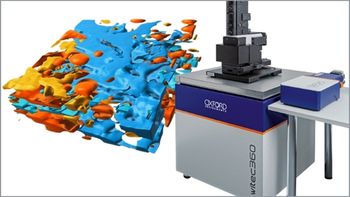
Phonon Imaging in 3D with a Fiber Probe
Salvatore La Cavera III and his colleagues in the Faculty of Engineering at the University of Nottingham, in Nottingham, United Kingdom have developed a novel measurement system consisting of two ultrafast lasers that excite and detect high-frequency ultrasound from a nano-transducer fabricated onto the tip of a single-mode optical fiber.
As science advances and the ability to study smaller and smaller entities becomes a necessity, laboratory professionals have had a need for an optical fiber-based ultrasonic imaging tool capable of resolving biological cell-sized objects—a need that, until recently, has gone unfulfilled. Salvatore La Cavera III and his colleagues in the Faculty of Engineering at the University of Nottingham, in Nottingham, United Kingdom have developed a novel measurement system consisting of two ultrafast lasers that excite and detect high-frequency ultrasound from a nano-transducer fabricated onto the tip of a single-mode optical fiber. The ability to extrapolate the single fiber to tens of thousands of fibers in an imaging bundle effectively demonstrates the endoscopic potential for this device, as it illustrates the ability to catalyze future phonon endomicroscopy technology, bringing the prospect of label-free in vivo histology within reach. La Cavera spoke to Spectroscopy about research using this tool.
Your paper (1) shows, for the first time, that a single ultrasonic imaging fiber is capable of simultaneously accessing 3D spatial information and mechanical properties from microscopic objects. What is the significance of this achievement?
Most endoscopes provide access to one human sense: sight. However, history has shown that clinical diagnostics and pathology are optimized through a wide range of sensory information, such as listening with a stethoscope, seeing with an endoscope, and even feeling with the clinician’s hand. Our technology provides a pathway for combining these latter two senses in an endoscopic context—viewing objects in 3D and feeling for their stiffness. The fact that this can be carried out on microscopic length scales is a tremendous opportunity. Imagine being able to perform biopsies or histopathology inside the human body, but with the added modality of being able to “see” the stiffness of a cancer cell relative to healthy cells.
What prompted you to address this subject in this way?
Mechanobiology, the study of how mechanical properties influence the building blocks of life and disease, is an exciting new field of study that is growing rapidly. One of the central themes in this young field is that the mechanical properties of cells play a vital role in their development, under both healthy and diseased conditions. Therefore, there is great interest in developing endoscopic and probe-based technology to expand the toolbox for mechanobiology and more quickly bring it into clinical practice.
Were there any previous research efforts, by yourself or others, that you found especially useful in advancing your work to this level?
The work presented in our latest publication is inspired by technology our laboratory has been developing for over a decade, but also by the works of many incredible researchers across several fields. The foundation of our technology was developed for the purpose of cell microscopy, which I repurposed in 2018-2019 for Brillouin spectroscopy at the tip of an optical fiber cable (which then led to the imaging capabilities presented here). Aside from the work of our group, the mechanisms used by our technology draw from the early theoretical and experimental work of J. Maris, J. Tauc, C. Thomsen, V. Gusev, O. Wright, O. Matsuda, G. Scarcelli, S.H. Yun, and others; there is also a great wealth of experience laid before us by the early development of photoacoustic endoscopy and all-optical laser ultrasound, through the works of L. Wang, P. Beard, A. Desjardins, and many others.
Briefly describe your discovery process, and how this differed from what was previously done.
The field of high-frequency acoustics has been under development for nearly half a century. Our approach has taken opto-acoustic sensor technology that has been widely reported since the 1980’s and has devised a way to make it an order of magnitude thinner, which means it can be deployed on the tip of a standard optical fiber (and therefore compatible with endoscopes). This overcomes many of the shortcomings of high-frequency acoustics–complex electrical systems and signals that quickly die– and provides access to its unique strengths such as high resolution and sensitivity to stiffness information.
Were there any particular challenges you encountered in your work?
Aside from the usual—instruments not working, exhaustion, hunger—the main challenges for the project were to do with the fabrication of the nanometer-sized sensors onto the tips of optical fiber (with good reproducibility), the engineering of the motion of the fiber-tip with nanometer-precision, and especially the signal processing of the acoustic signals to extract 3D information.
What sort of feedback did you receive regarding this work?
Young technologies, such as ours, tend to receive a broad spectrum of feedback. Some people get it right away and are very enthusiastic and complimentary; others are skeptical and may not resonate with the work or see the vision. Both sides have been equally integral for the development of our technology, and in shaping how we tell the story of our device. Especially feedback and encouragement from colleagues who have helped drive its development.
What are the next steps in this research?
In order to keep driving the technology towards maturity and future industrial and clinical applications, the acquisition speed of the system will need to be increased. There are a number of pathways toward achieving this which will be exciting to pursue. Additionally, the compatibility of the technology and signal processing with various biological tissues will be a key next step. Application to biology will be greatly enabled by increasing how deeply into tissue the device can probe. Ultimately, we are aiming to introduce our optical fibersystem into the human body and inspect stiffness in diseased cell/tissue towards in vivo biopsies.
Are there any specific references to your work that would be helpful for our readers in understanding your research?
Our initial development of the optical fiber Brillouin spectrometer can be found at
References
- S. La Cavera, F. Pérez-Cota, R.J. Smith, et al., Light Sci Appl 10, 91 (2021).
https://doi.org/10.1038/s41377-021-00532-7 - S. La Cavera, F. Pérez-Cota, R. Fuentes-Domínguez, R. J. Smith, and M.Clark, Opt. Express 27 25064-25071 (2019).
https://doi.org/10.1364/OE.27.025064 - F. Pérez-Cota, R. Fuentes-Domínguez, S. La Cavera, et al., J. Appl. Phys. 128, 16090 (2020).
https://doi.org/10.1063/5.0023744 - R.J. Smith, F. Pérez-Cota, L.Marques, et al., Sci. Rep. 11, 3301 (2021).
https://doi.org/10.1038/s41598-021-82639-w - F. Pérez-Cota, R.Smith, E. Moradi, et al. Sci Rep 6, 39326 (2016).
https://doi.org/10.1038/srep39326
Salvatore La Cavera III is an EPSRC Doctoral Prize Fellow in the Optics and Photonics Research Group at the University of Nottingham, in Nottingham, United Kingdom, where he is developing phonon-based endoscopes for high resolution and high contrast imaging and tissue characterization. He holds a bachelor's degree in Physics, a master's in Photonic and Optical Engineering, and a doctorate in Electrical and Electronic Engineering from the University of Nottingham.
Newsletter
Get essential updates on the latest spectroscopy technologies, regulatory standards, and best practices—subscribe today to Spectroscopy.





